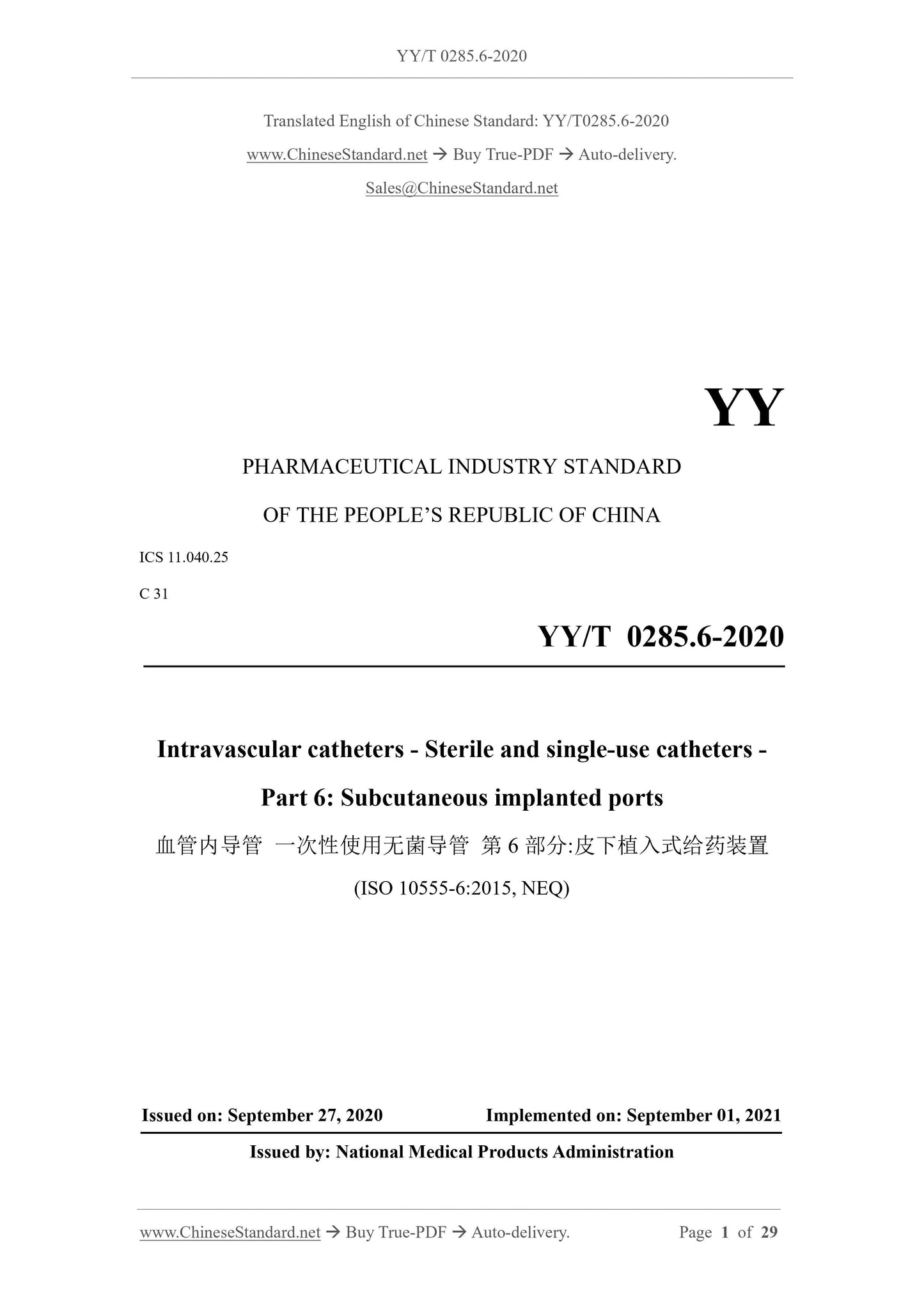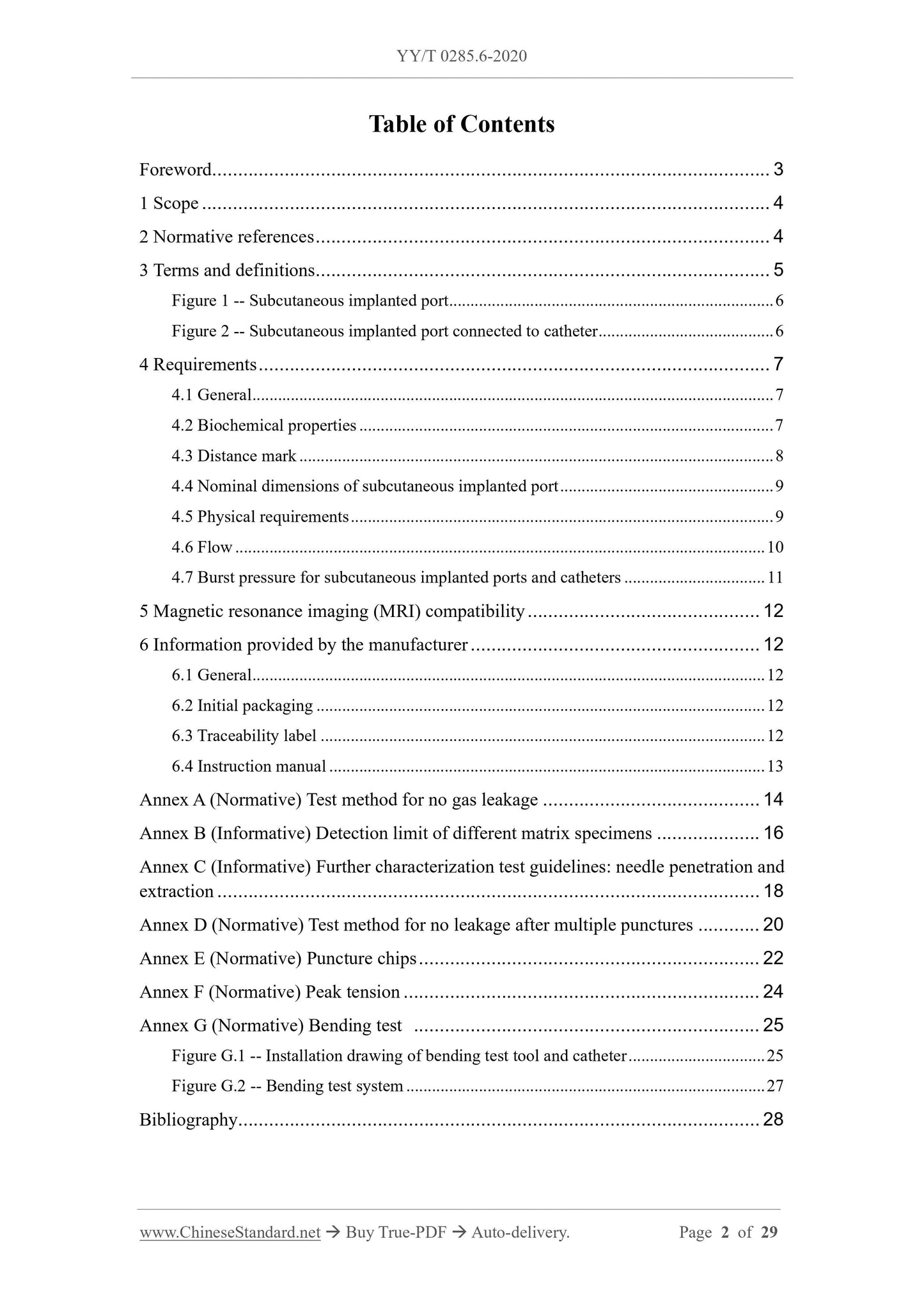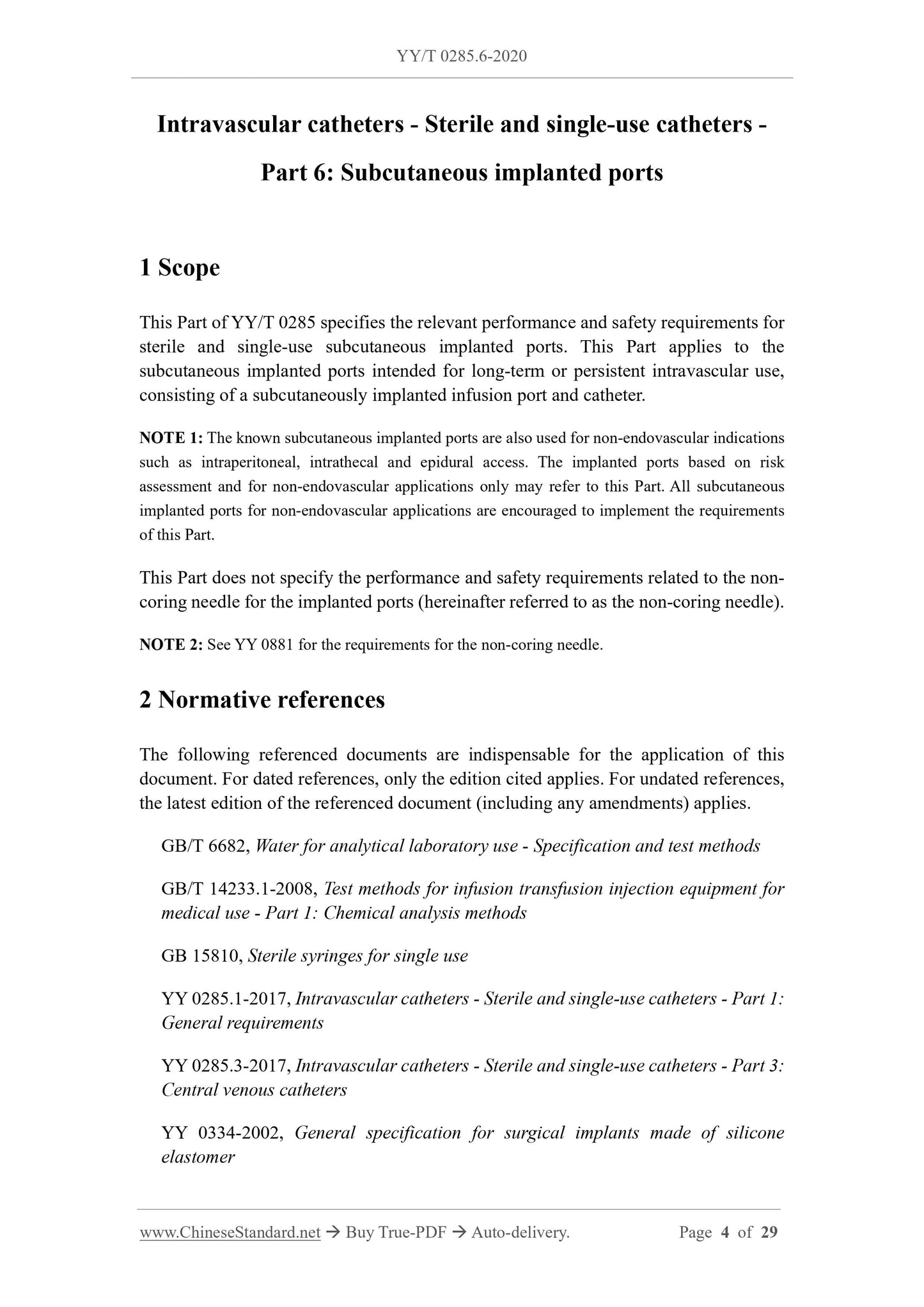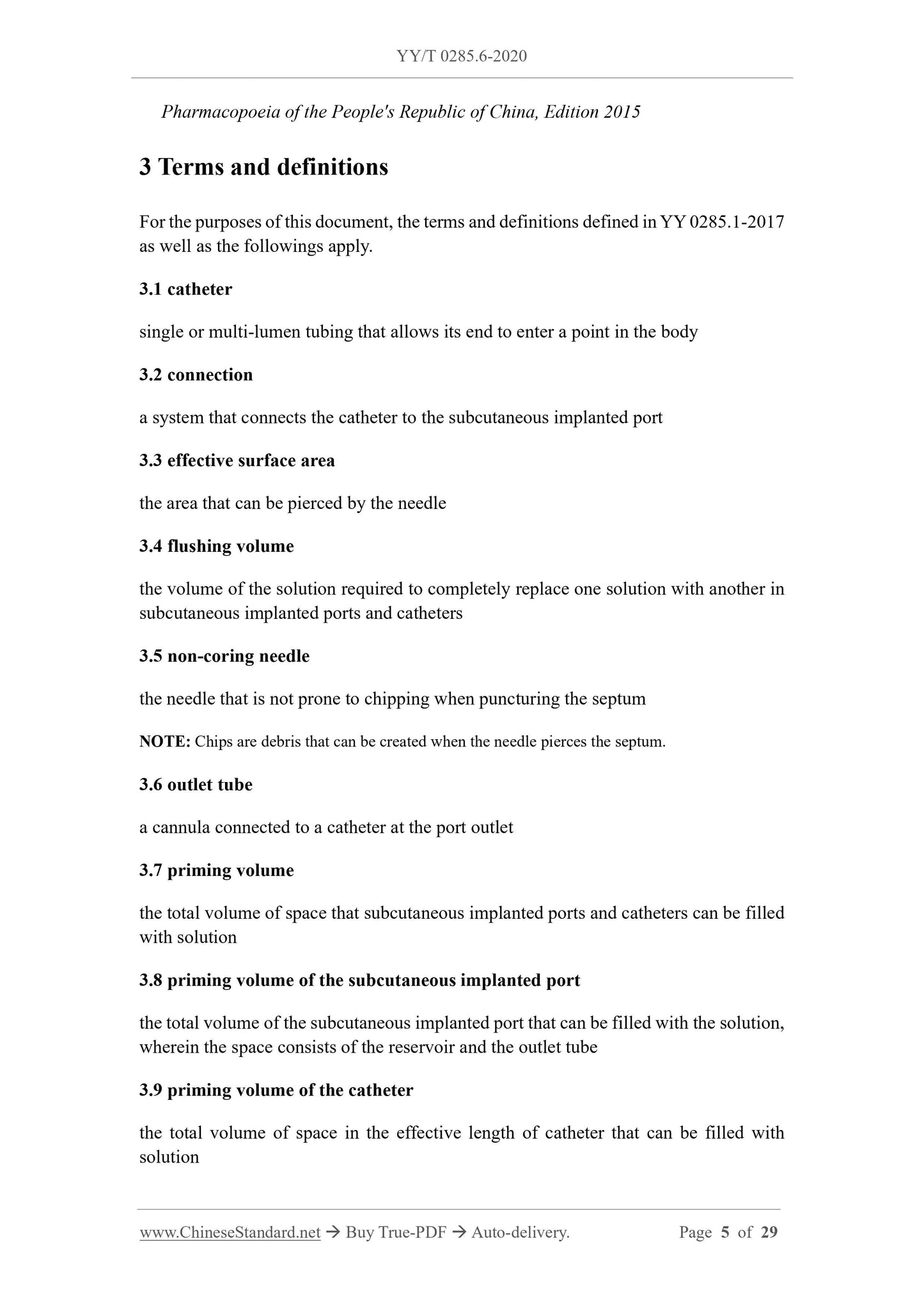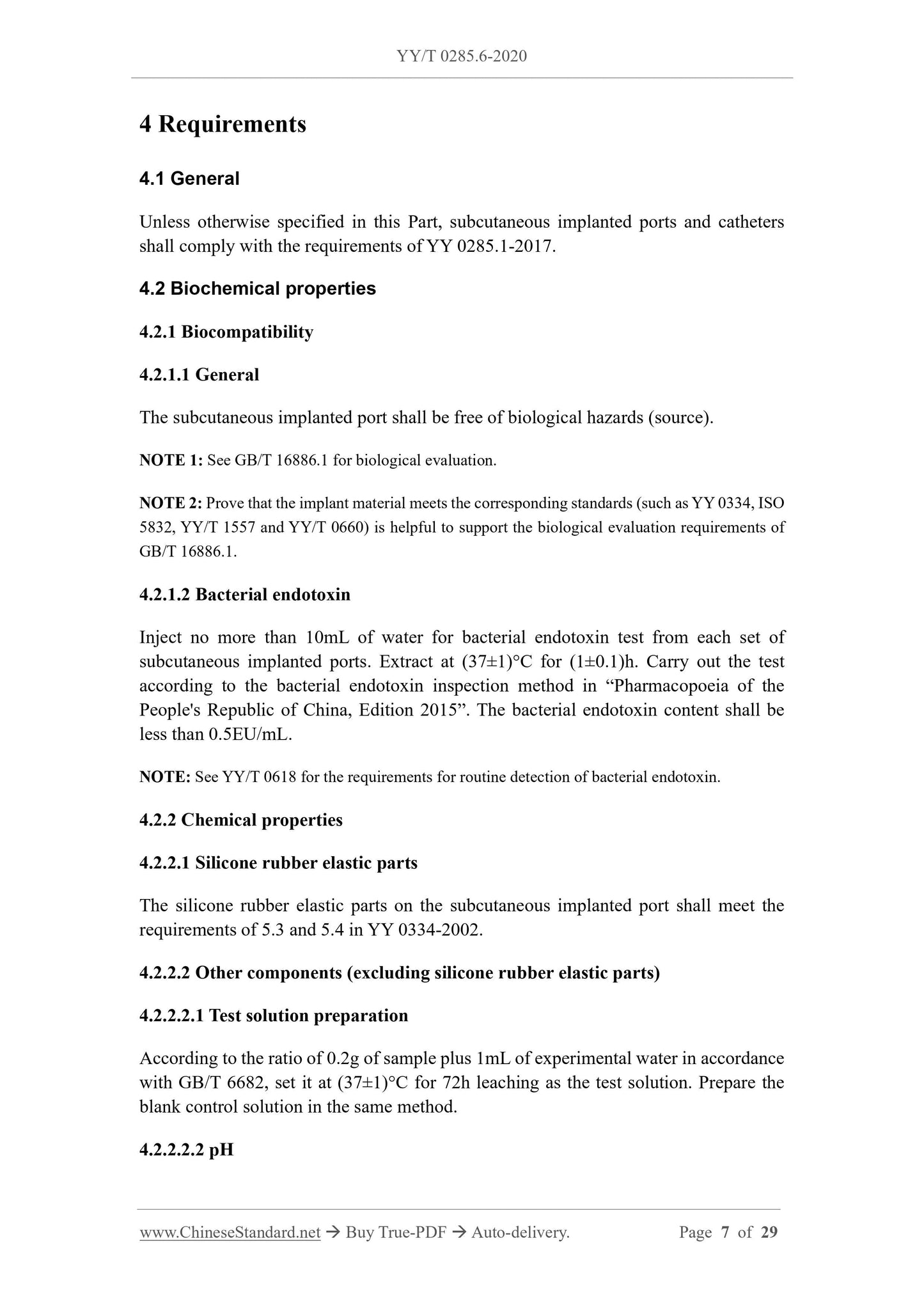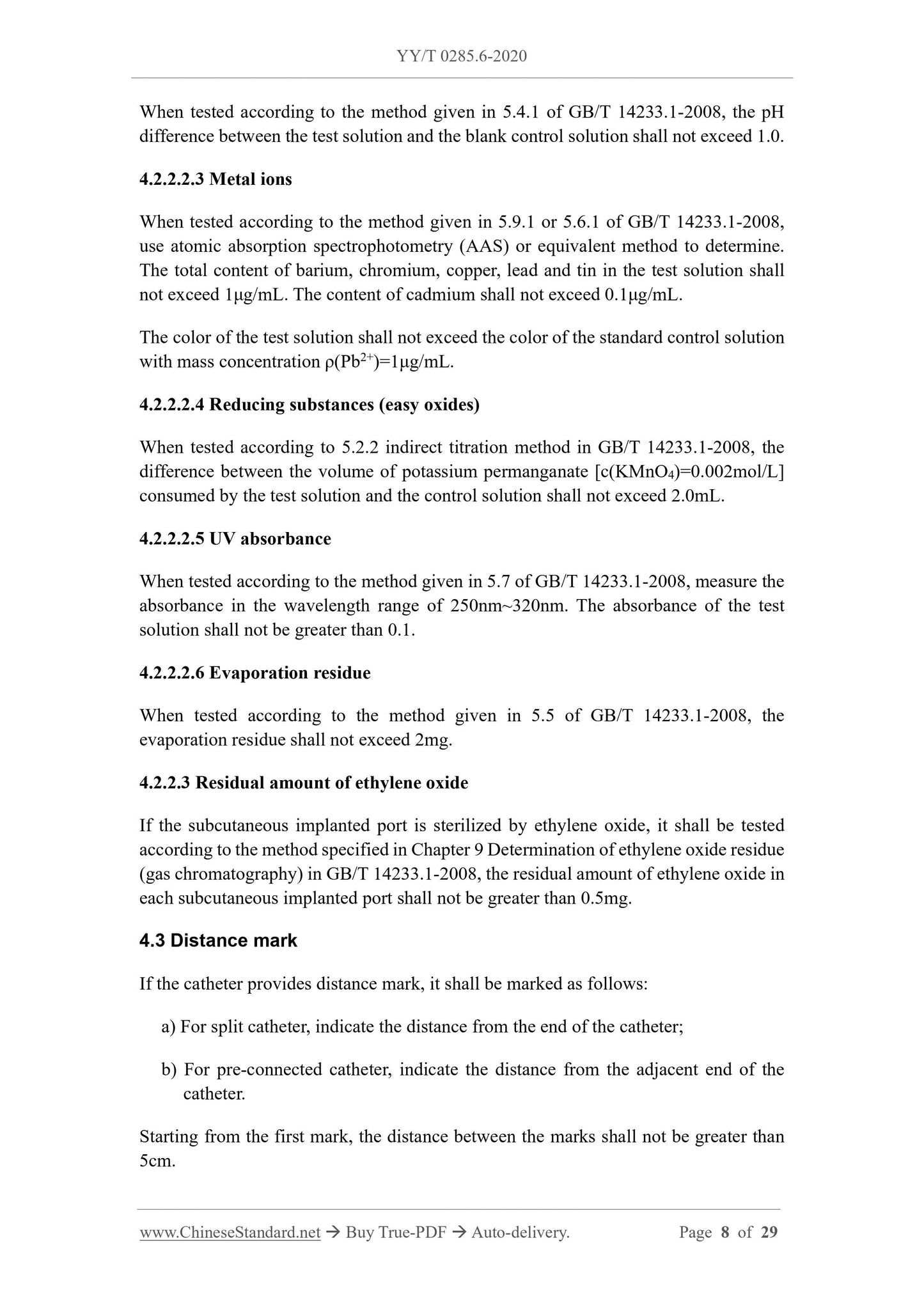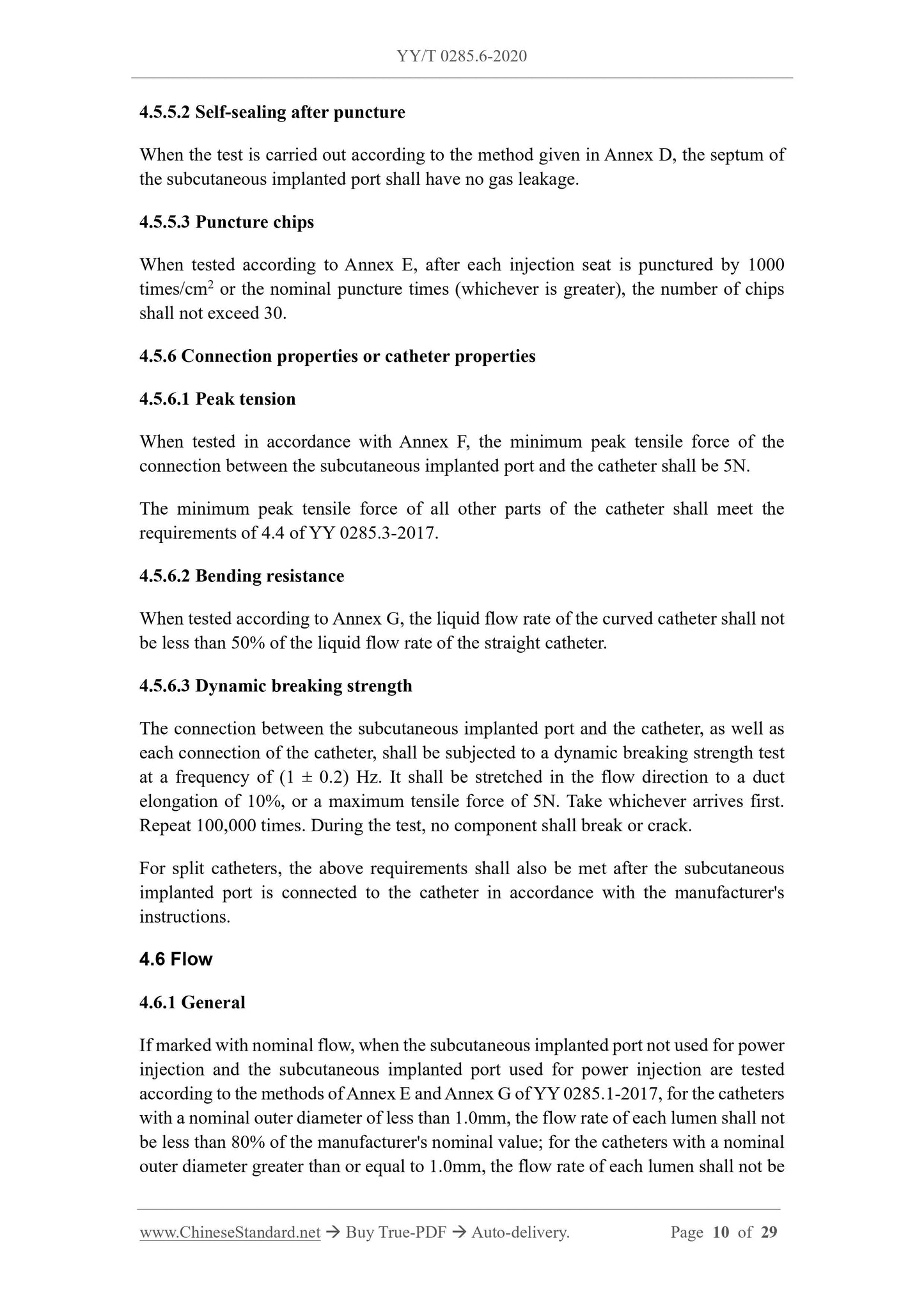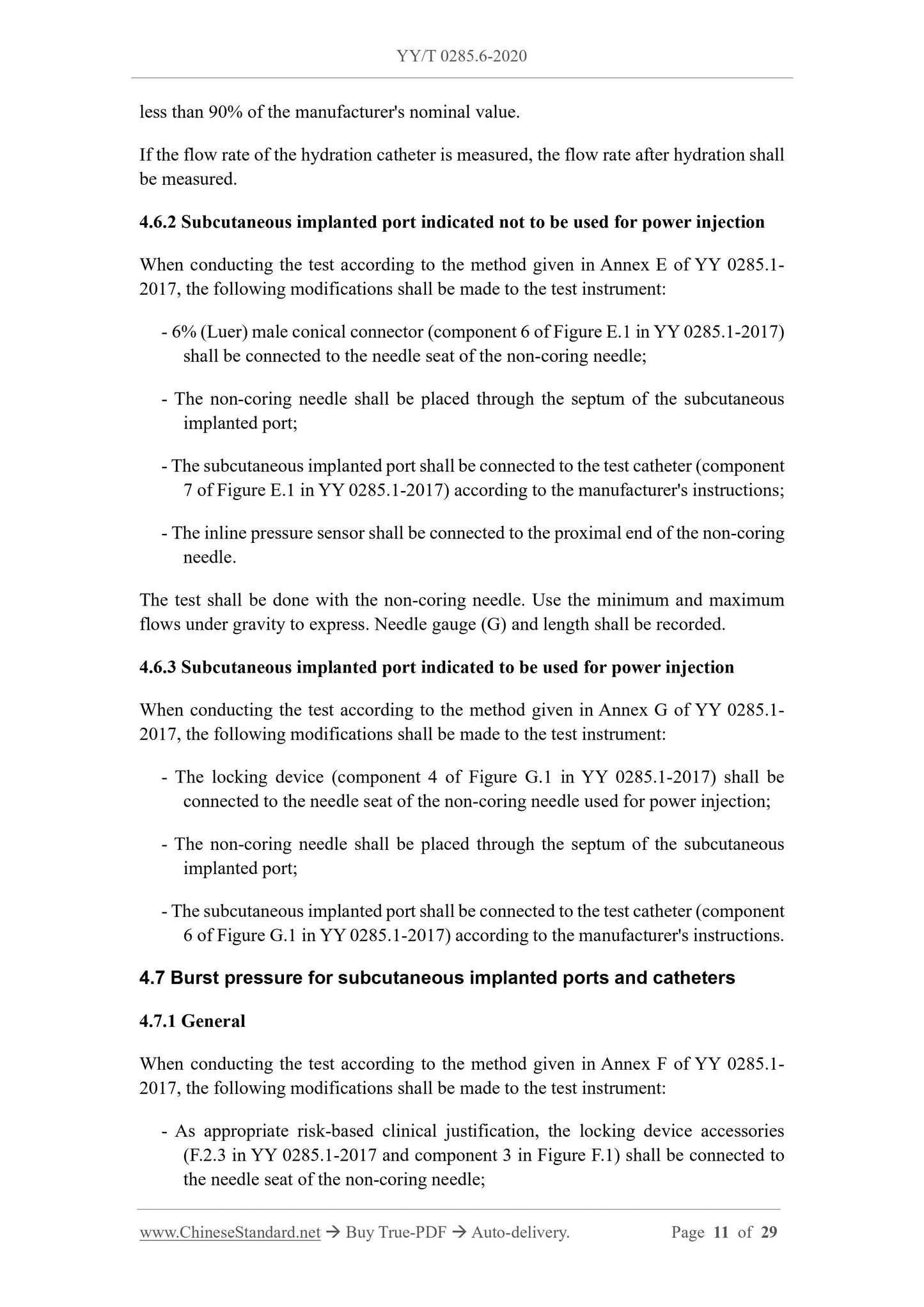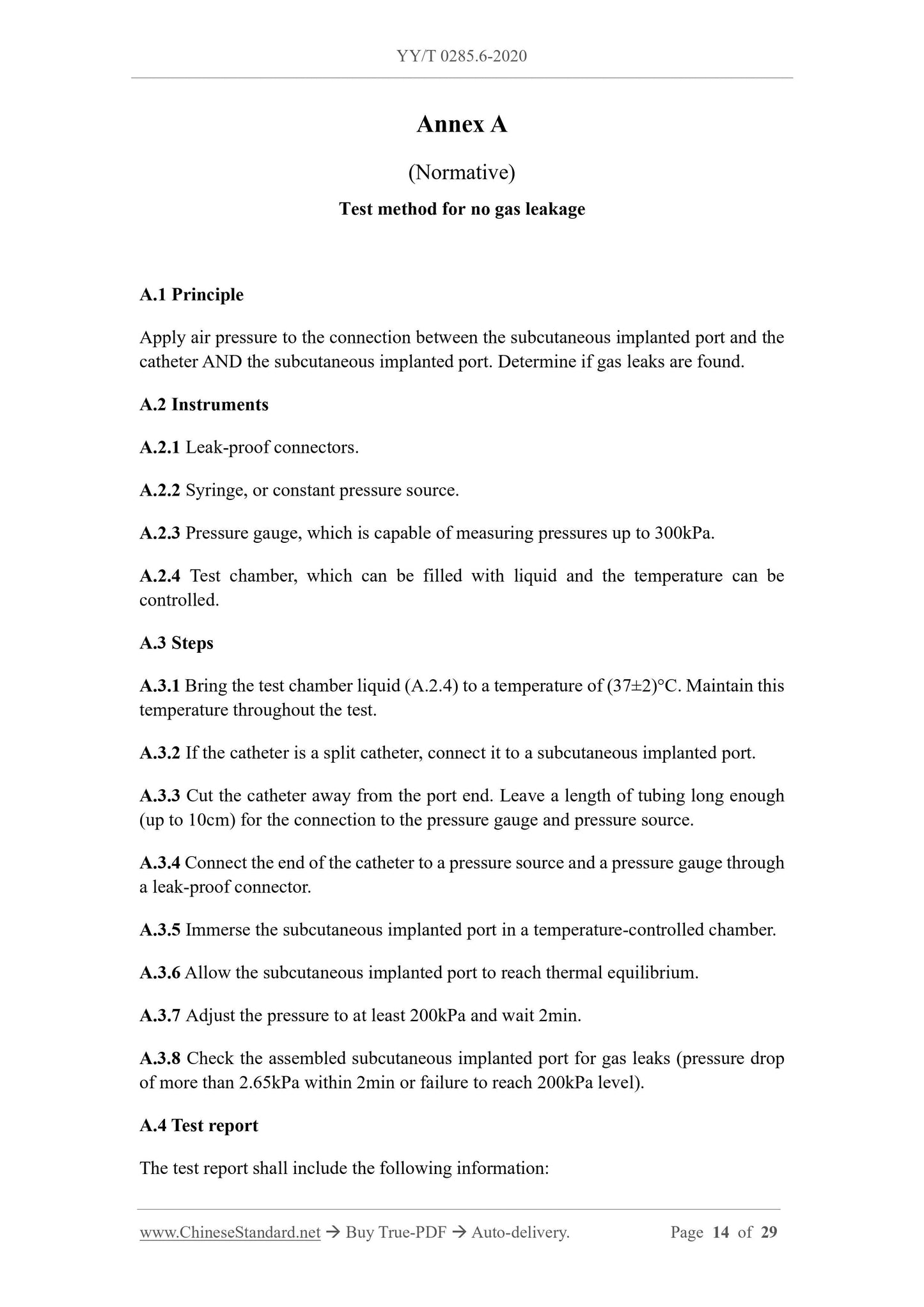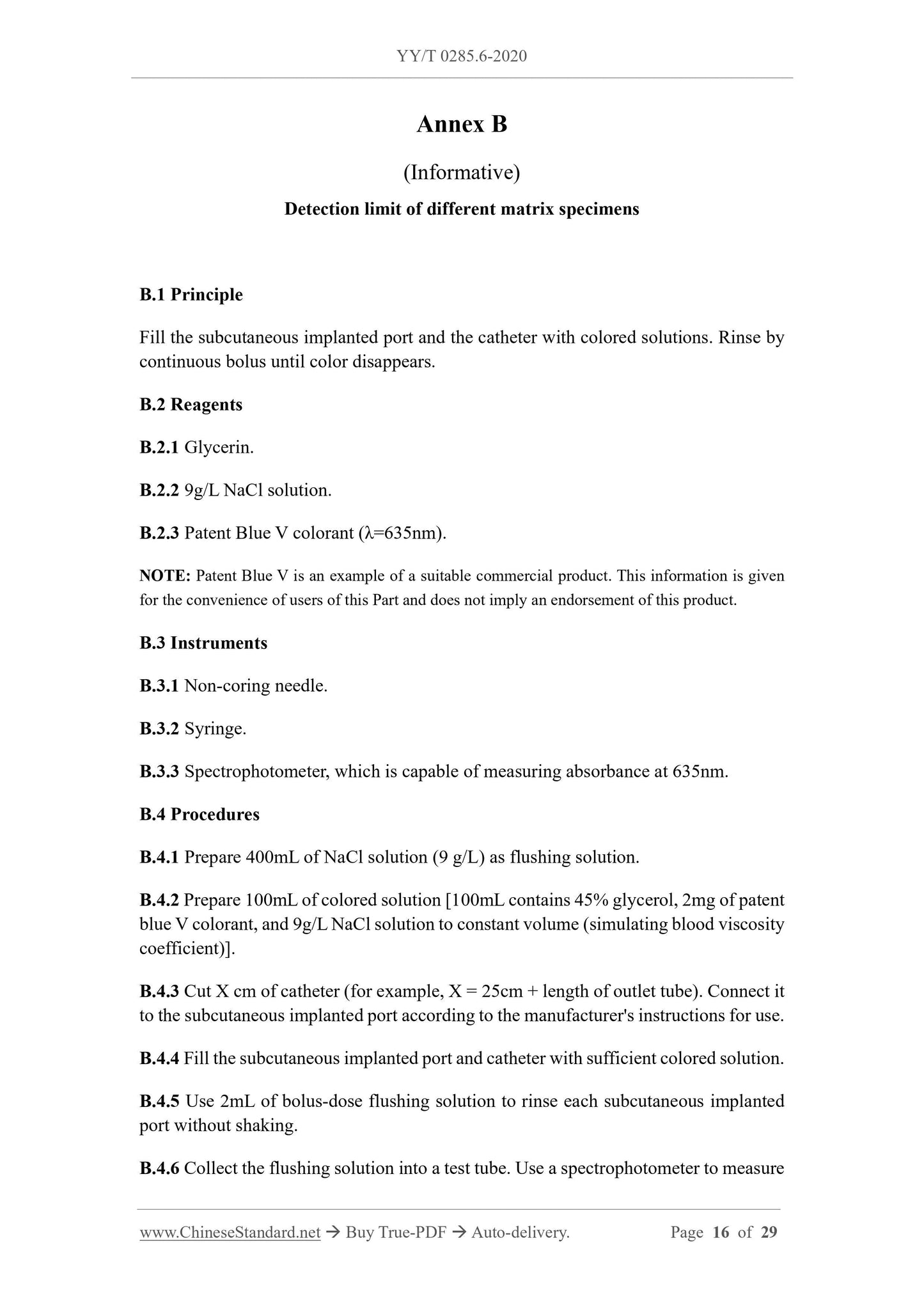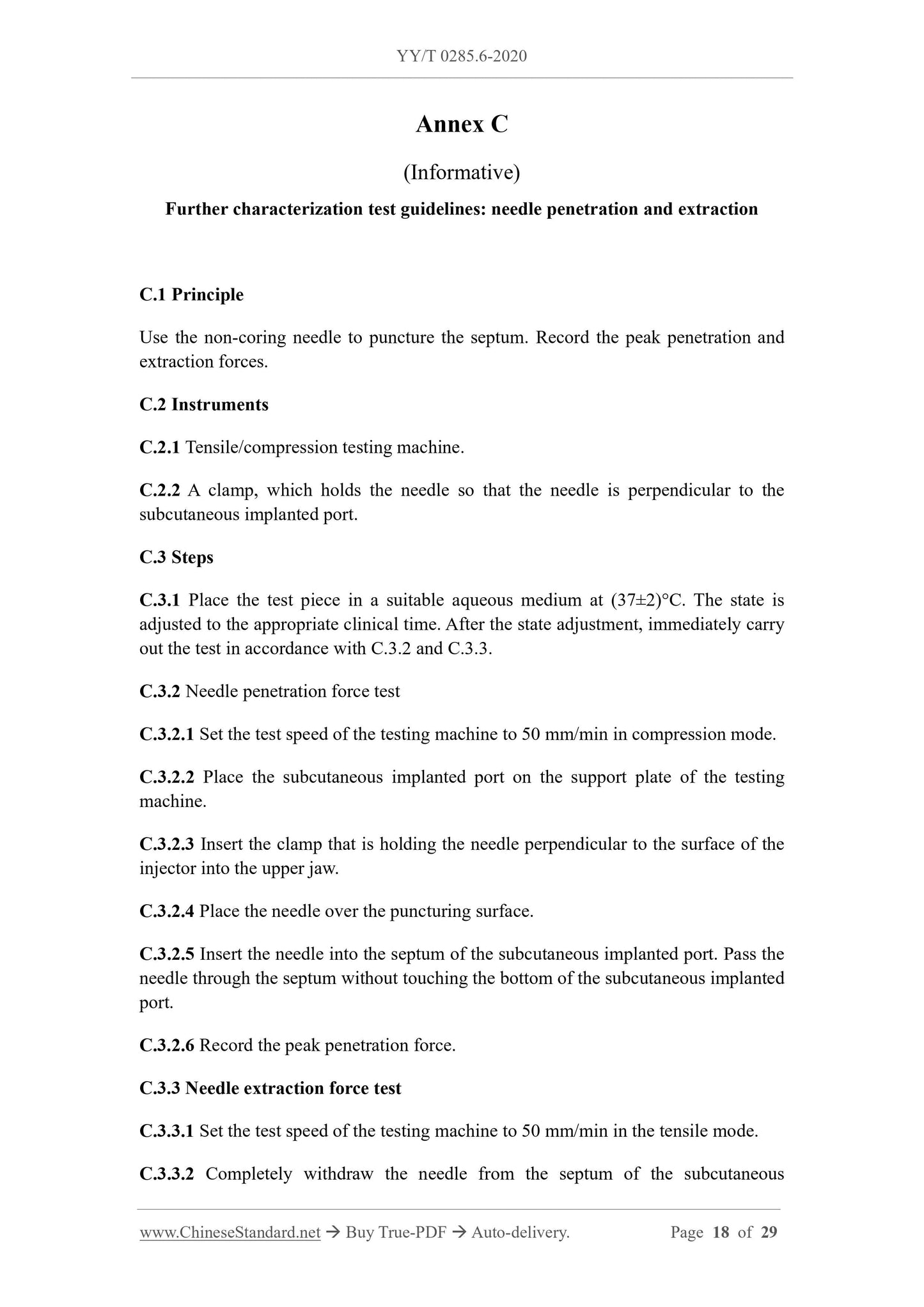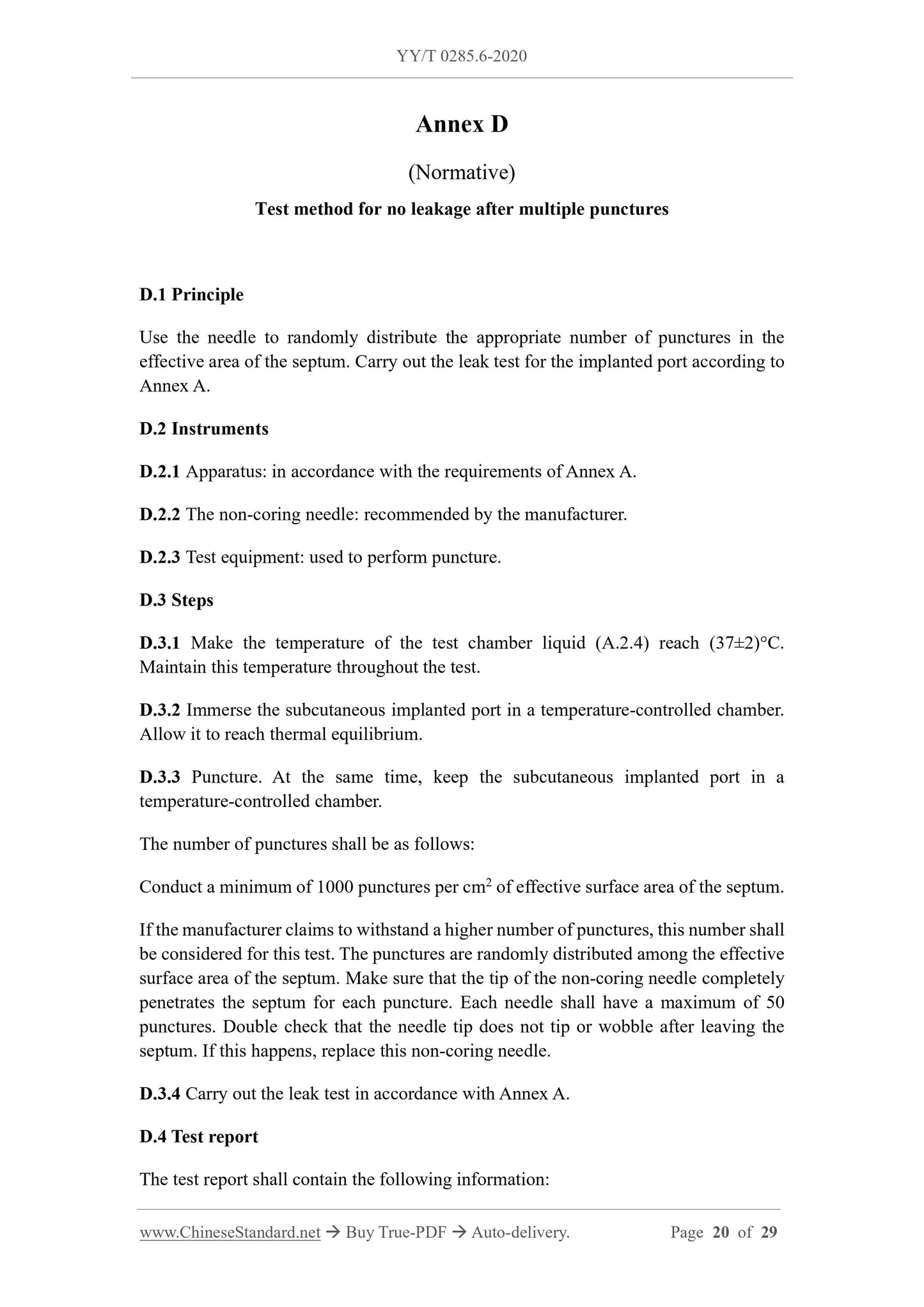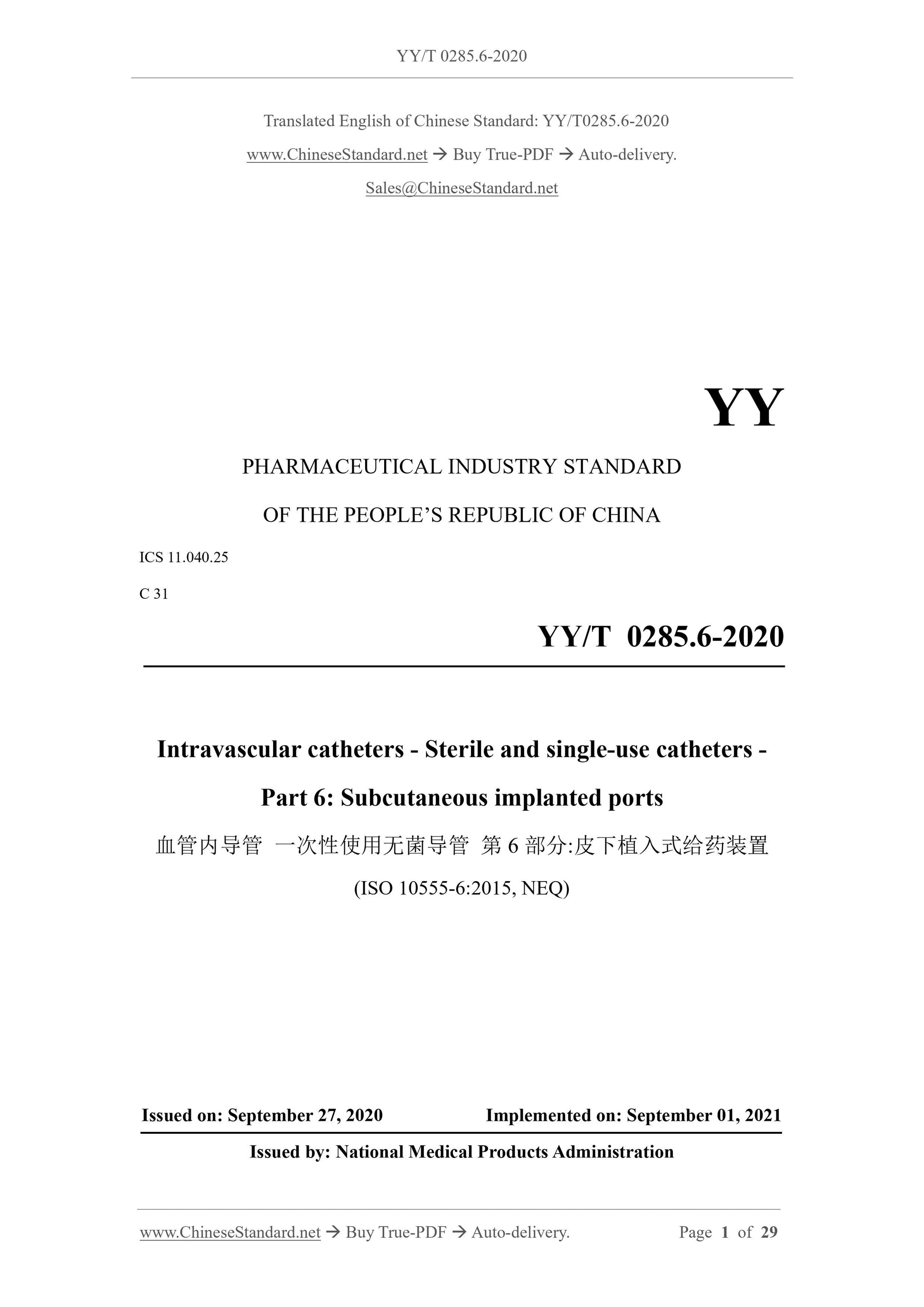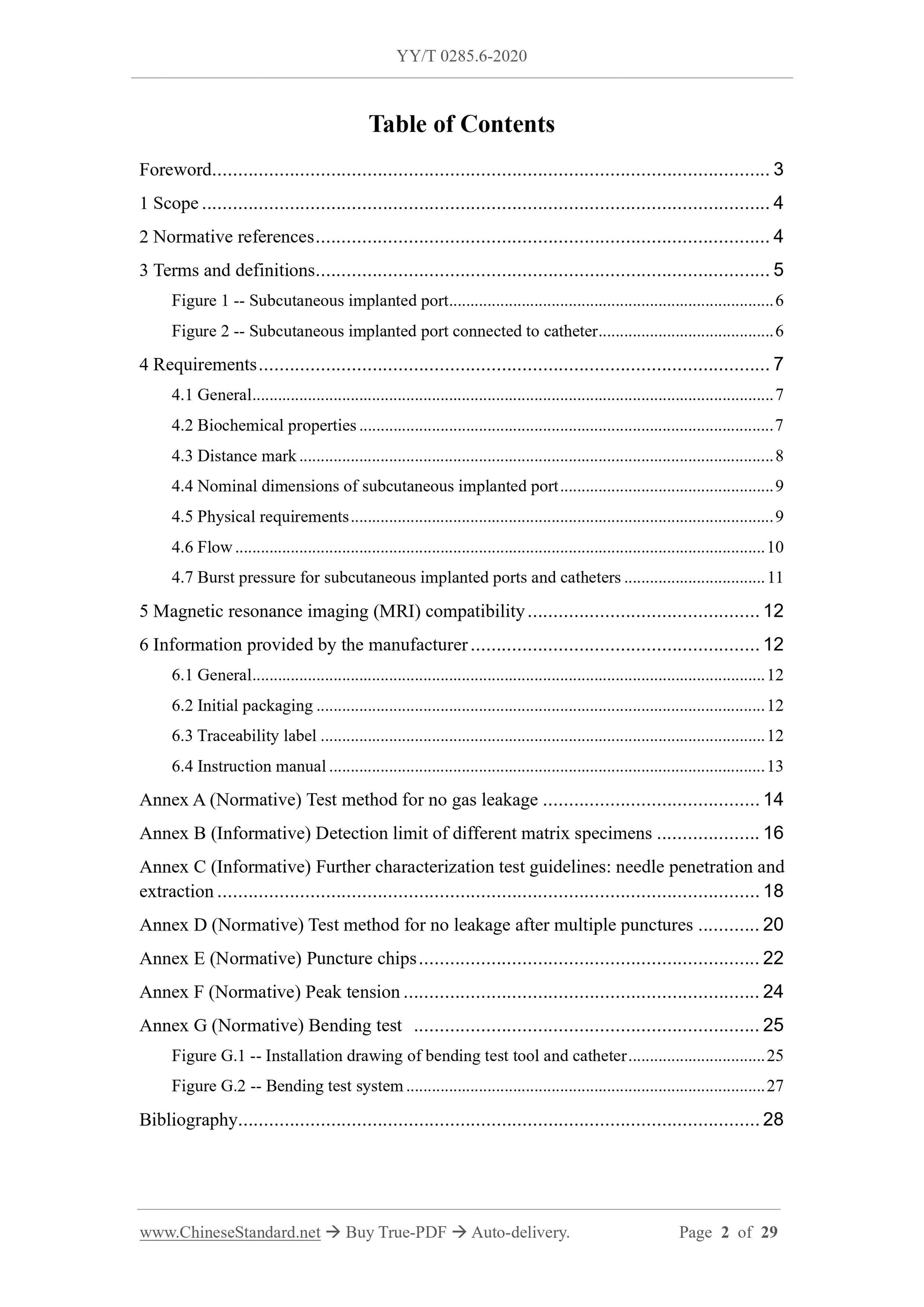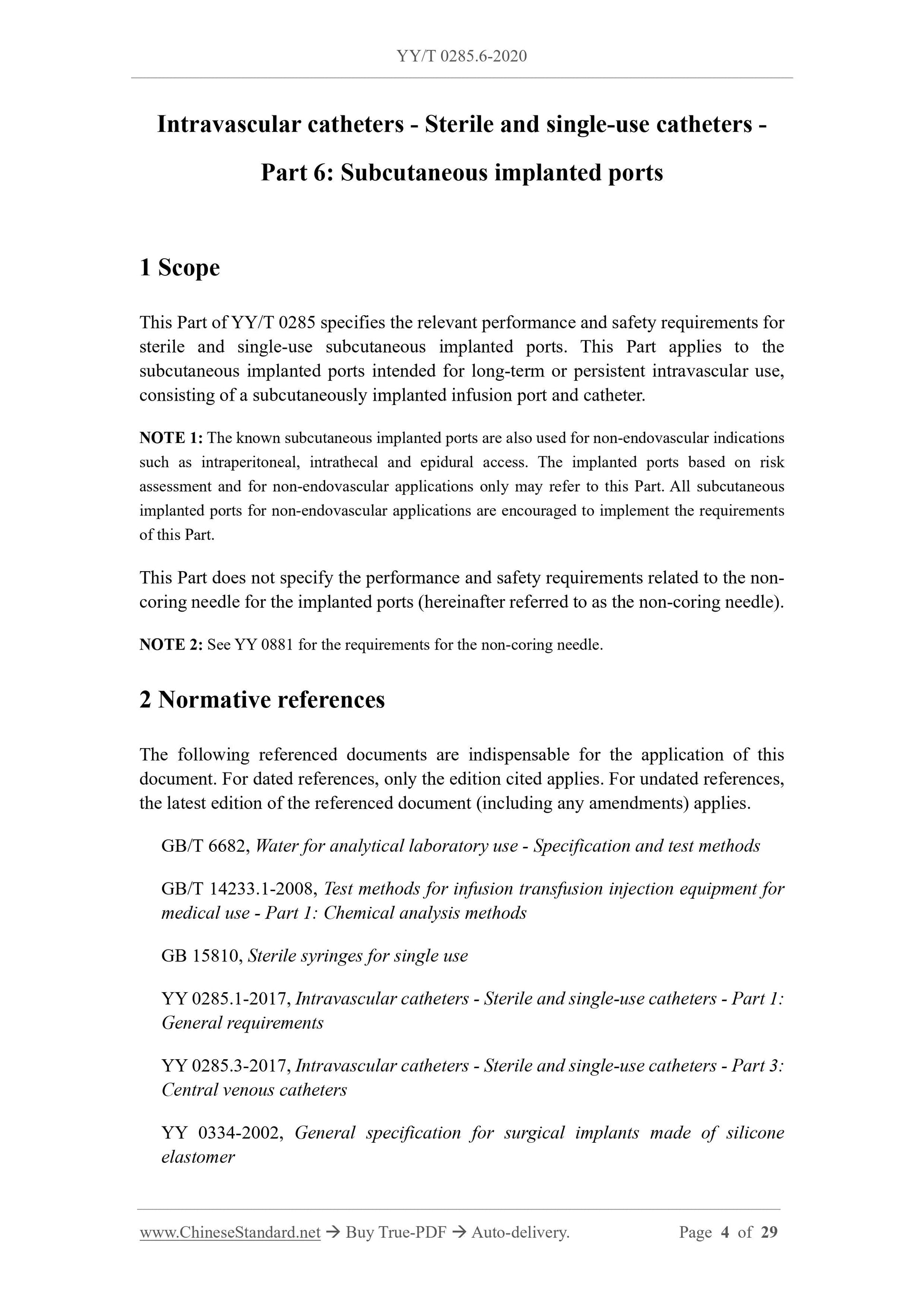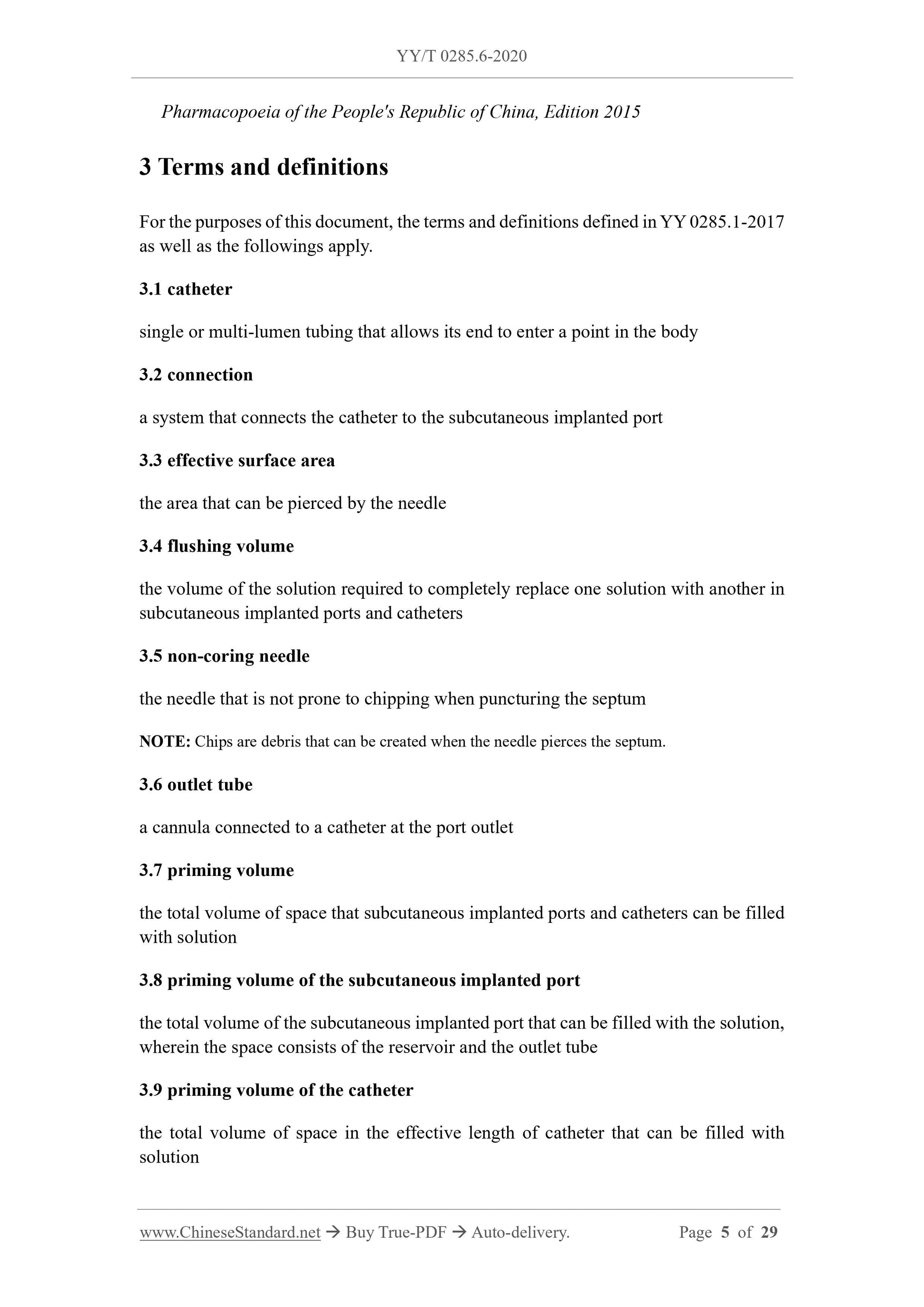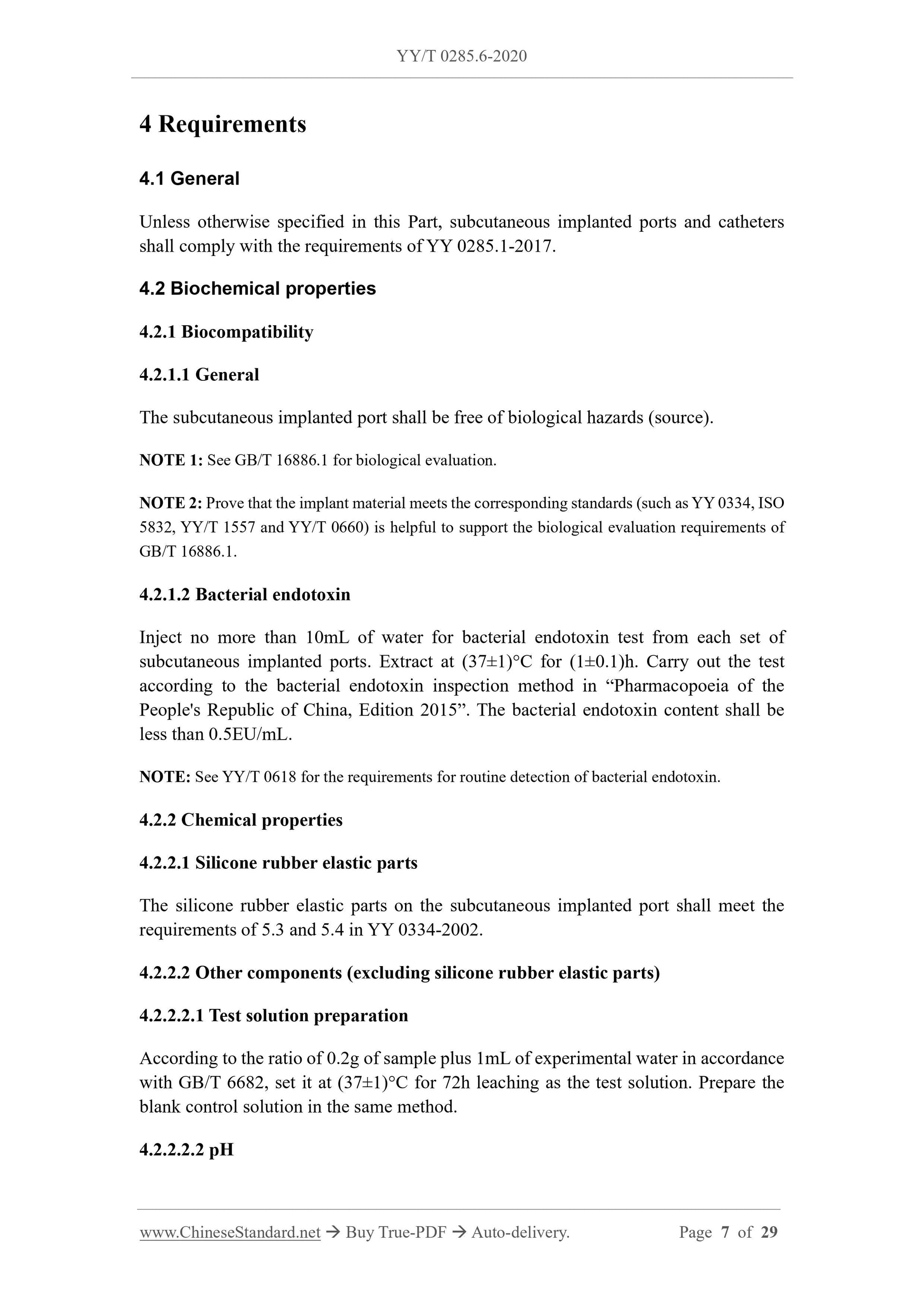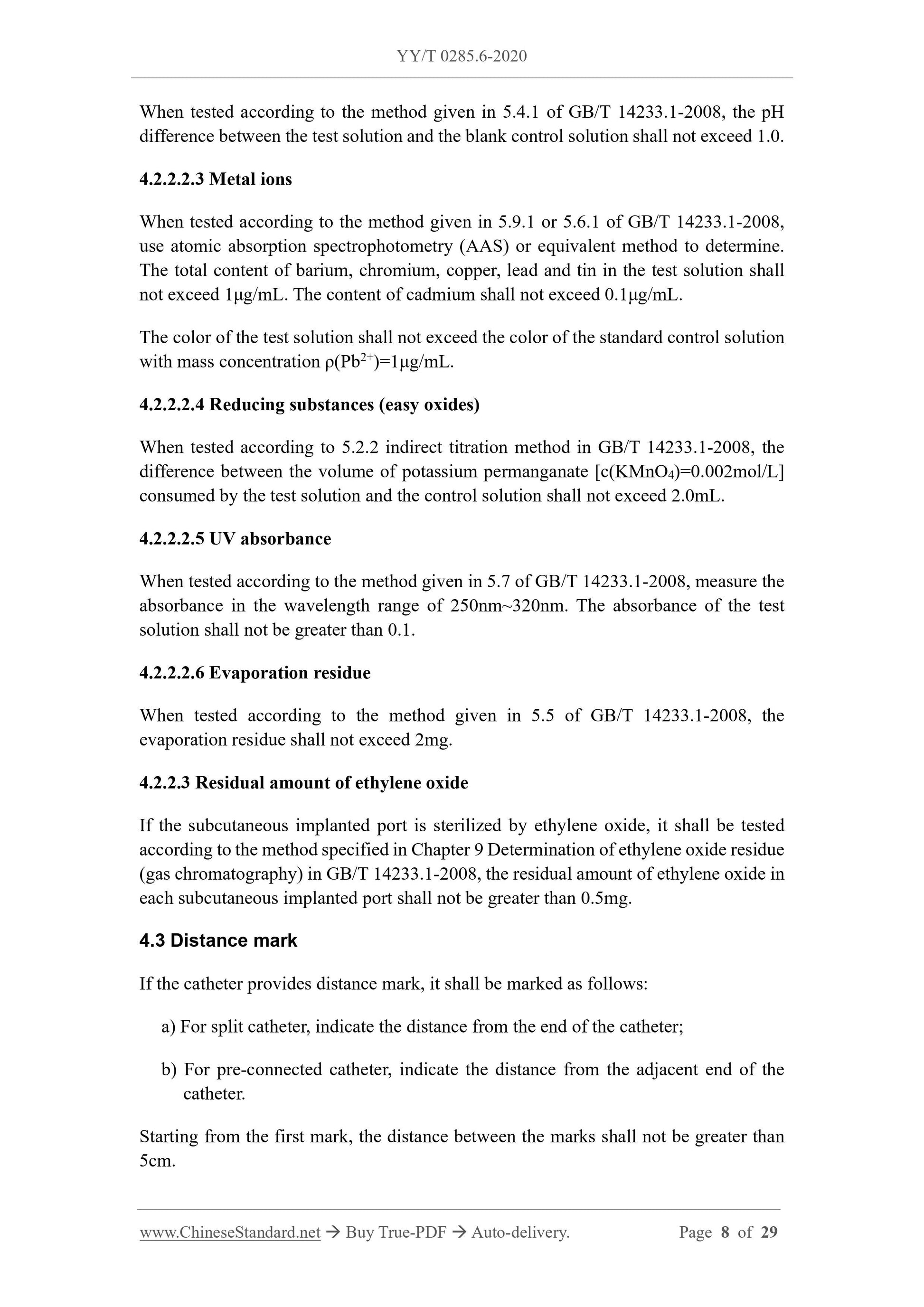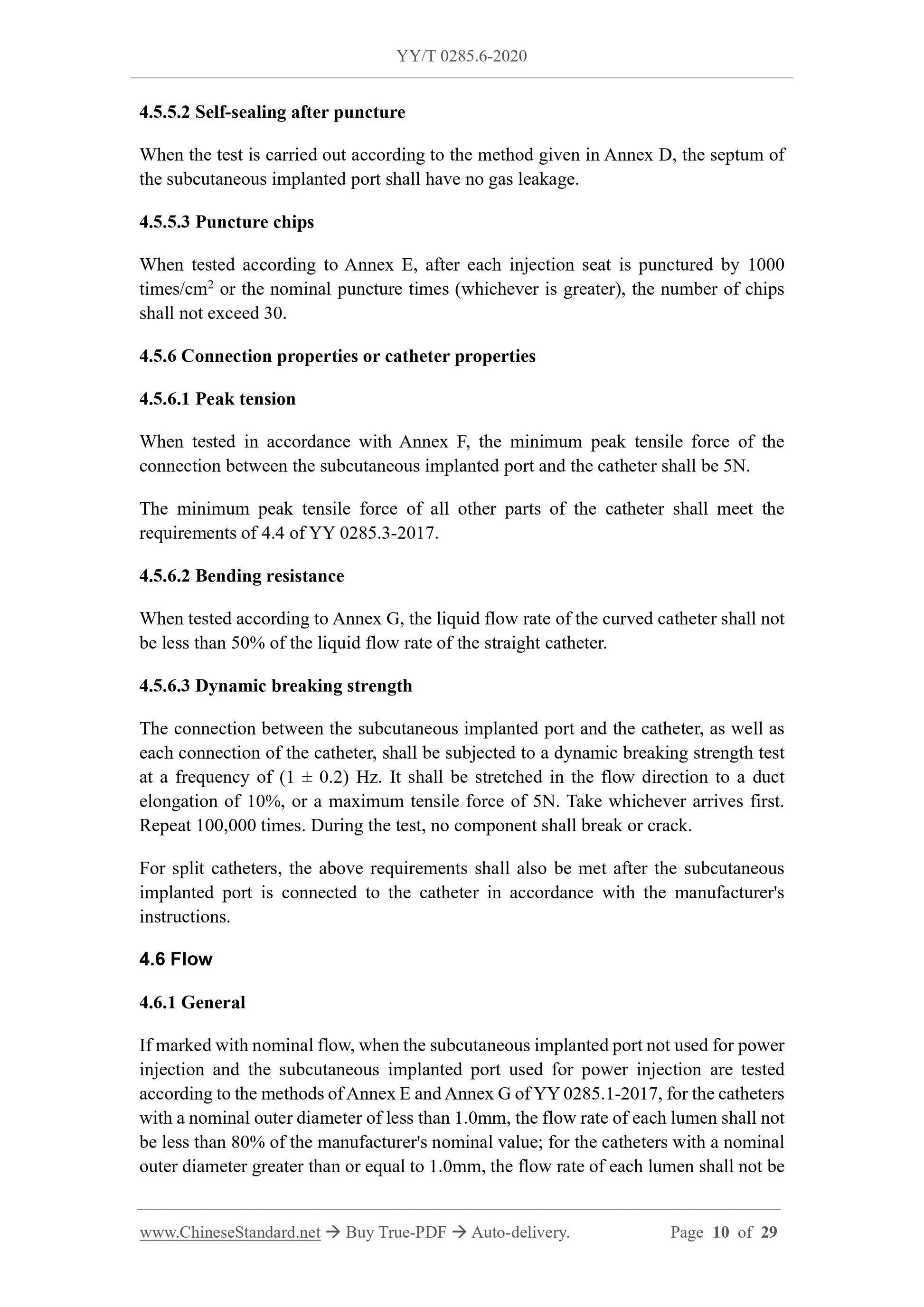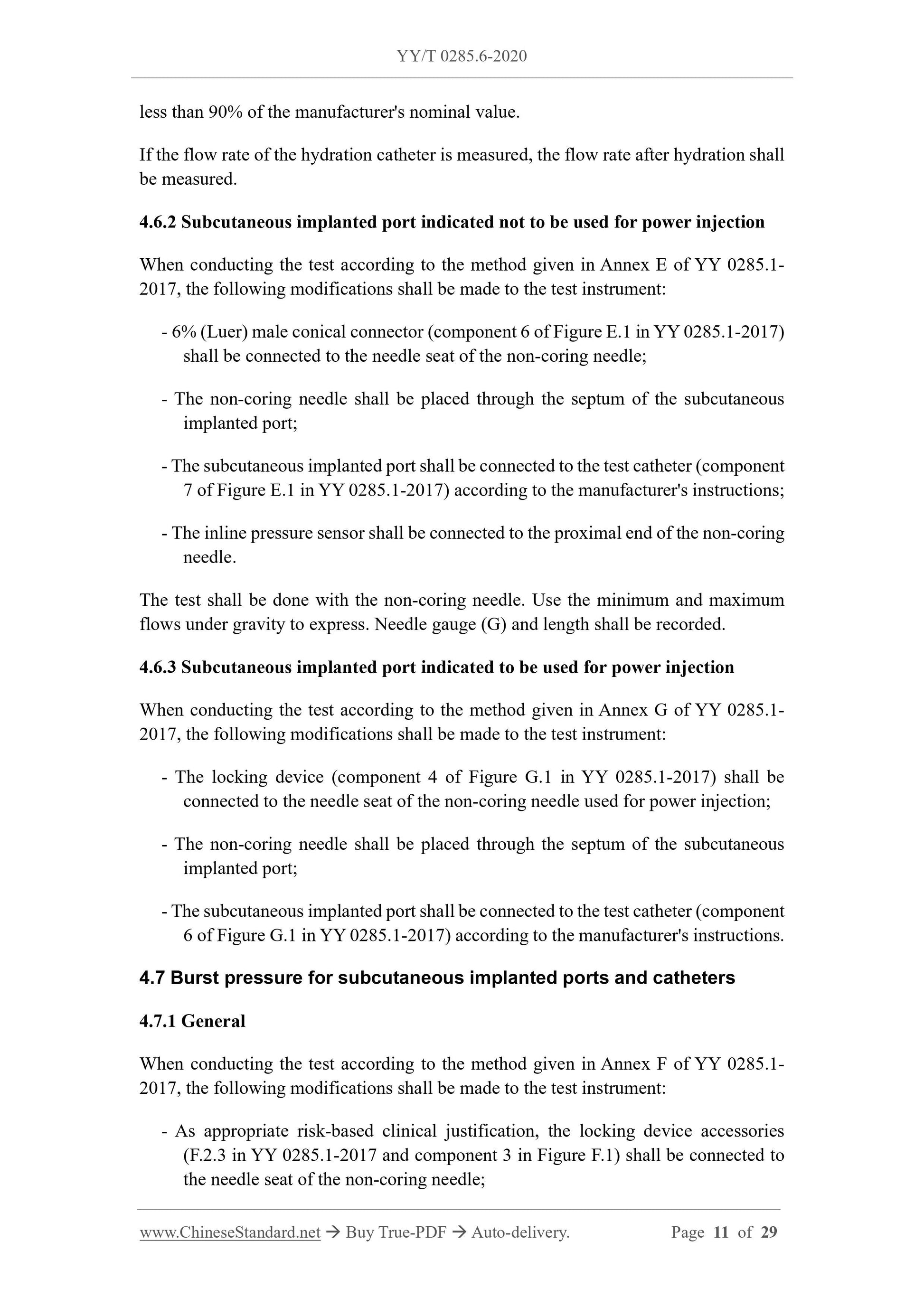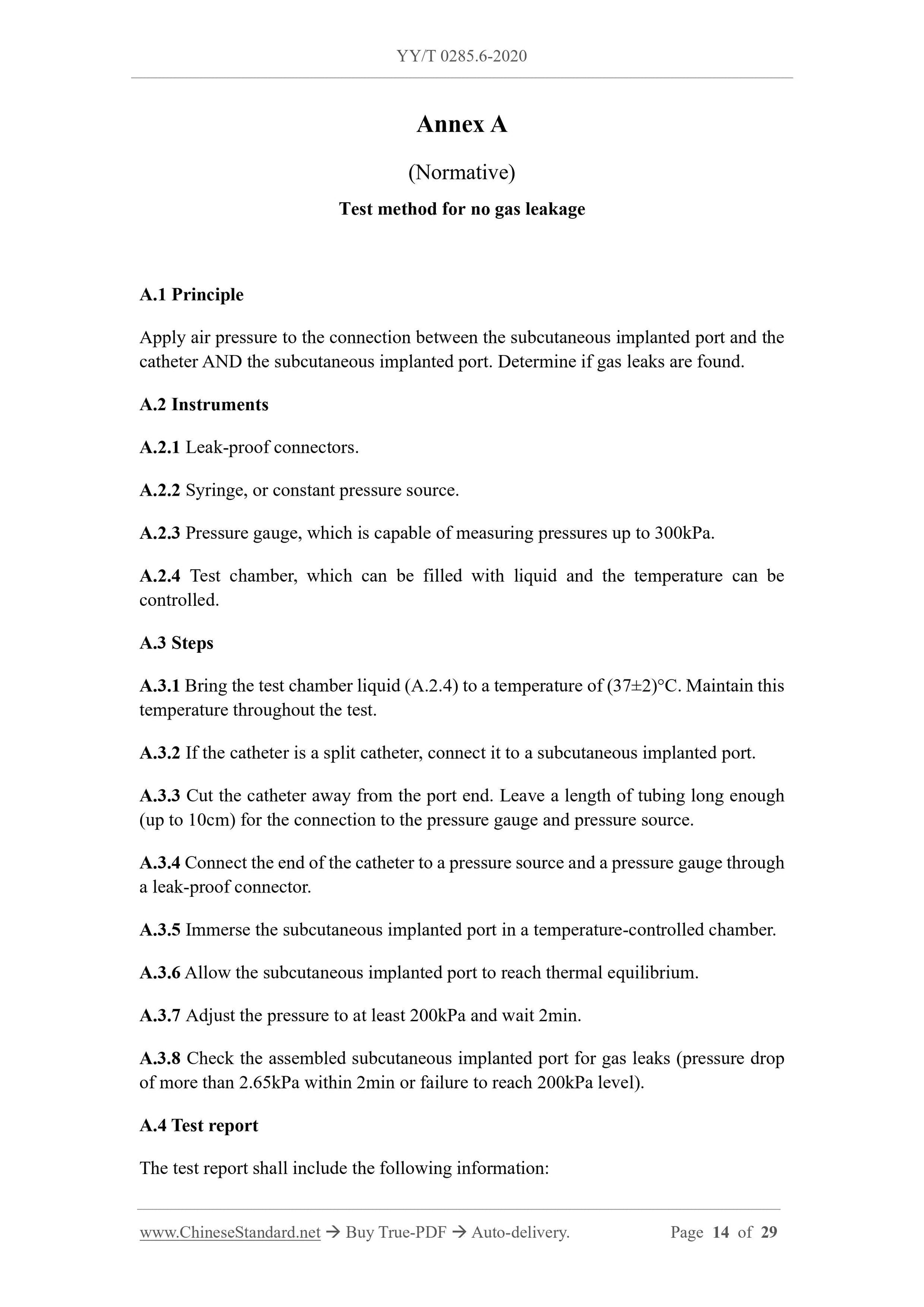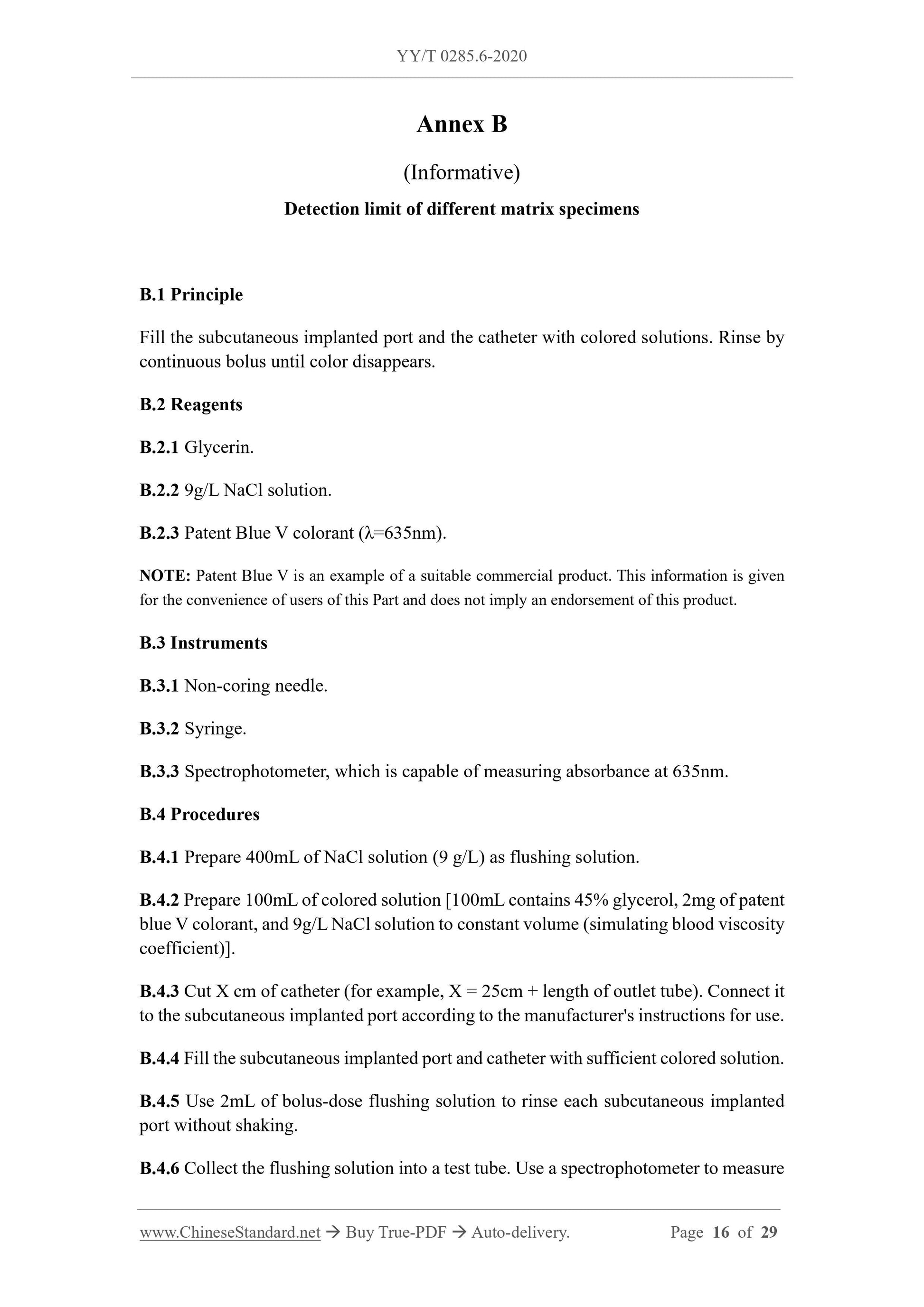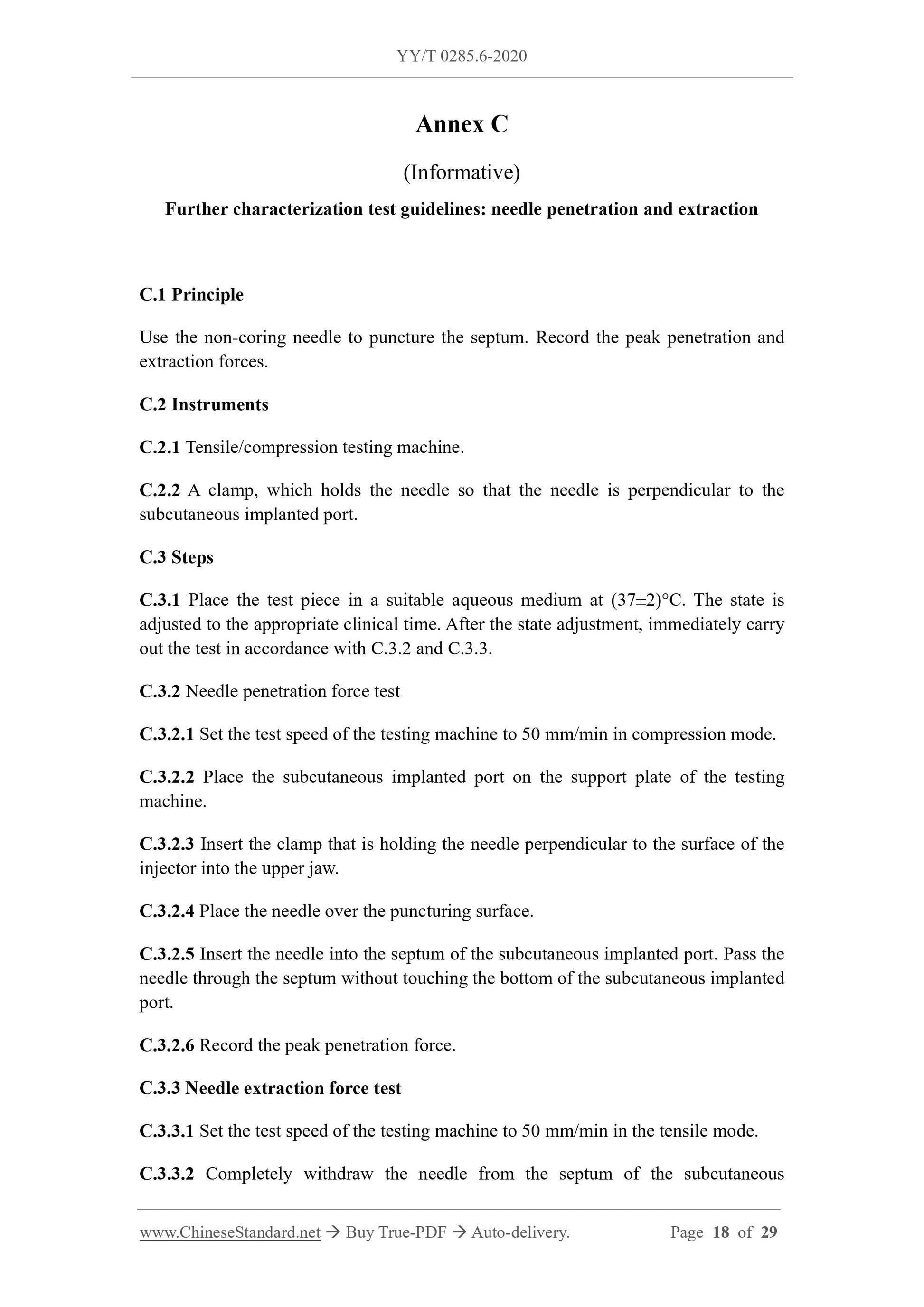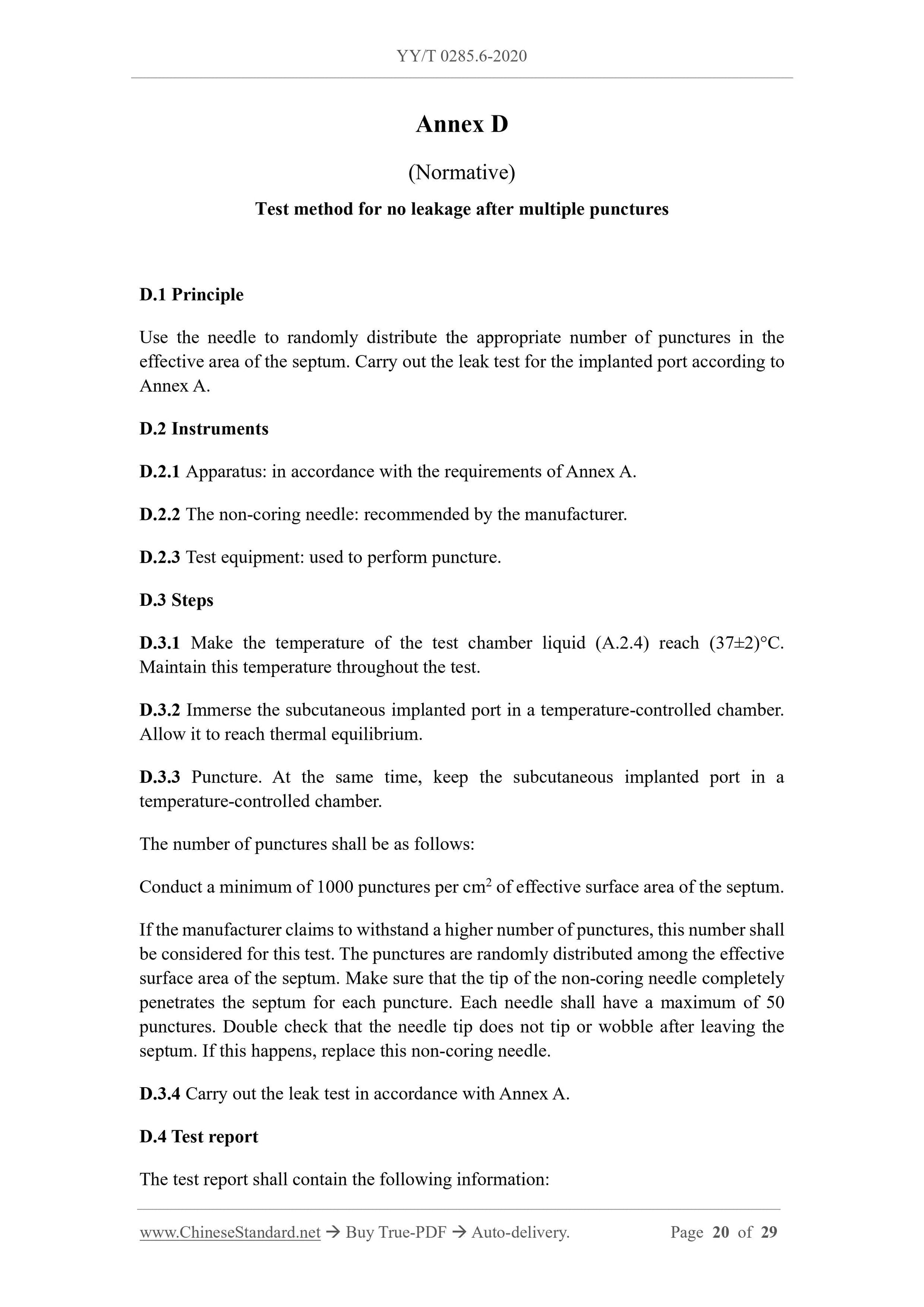1
/
su
12
PayPal, credit cards. Download editable-PDF & invoice in 1 second!
YY/T 0285.6-2020 English PDF (YYT0285.6-2020)
YY/T 0285.6-2020 English PDF (YYT0285.6-2020)
Prezzo di listino
$305.00 USD
Prezzo di listino
Prezzo scontato
$305.00 USD
Prezzo unitario
/
per
Spese di spedizione calcolate al check-out.
Impossibile caricare la disponibilità di ritiro
Delivery: 3 seconds. Download true-PDF + Invoice.
Get QUOTATION in 1-minute: Click YY/T 0285.6-2020
Historical versions: YY/T 0285.6-2020
Preview True-PDF (Reload/Scroll if blank)
YY/T 0285.6-2020: Intravascular catheters -- Sterile and single-use catheters -- Part 6: Subcutaneous implanted ports
YY/T 0285.6-2020
PHARMACEUTICAL INDUSTRY STANDARD
OF THE PEOPLE’S REPUBLIC OF CHINA
ICS 11.040.25
C 31
Intravascular catheters - Sterile and single-use catheters -
Part 6: Subcutaneous implanted ports
(ISO 10555-6:2015, NEQ)
ISSUED ON: SEPTEMBER 27, 2020
IMPLEMENTED ON: SEPTEMBER 01, 2021
Issued by: National Medical Products Administration
Table of Contents
Foreword ... 3
1 Scope ... 4
2 Normative references ... 4
3 Terms and definitions... 5
Figure 1 -- Subcutaneous implanted port ... 6
Figure 2 -- Subcutaneous implanted port connected to catheter ... 6
4 Requirements ... 7
4.1 General ... 7
4.2 Biochemical properties ... 7
4.3 Distance mark ... 8
4.4 Nominal dimensions of subcutaneous implanted port ... 9
4.5 Physical requirements ... 9
4.6 Flow ... 10
4.7 Burst pressure for subcutaneous implanted ports and catheters ... 11
5 Magnetic resonance imaging (MRI) compatibility ... 12
6 Information provided by the manufacturer ... 12
6.1 General ... 12
6.2 Initial packaging ... 12
6.3 Traceability label ... 12
6.4 Instruction manual ... 13
Annex A (Normative) Test method for no gas leakage ... 14
Annex B (Informative) Detection limit of different matrix specimens ... 16
Annex C (Informative) Further characterization test guidelines: needle penetration and
extraction ... 18
Annex D (Normative) Test method for no leakage after multiple punctures ... 20
Annex E (Normative) Puncture chips ... 22
Annex F (Normative) Peak tension ... 24
Annex G (Normative) Bending test ... 25
Figure G.1 -- Installation drawing of bending test tool and catheter ... 25
Figure G.2 -- Bending test system ... 27
Bibliography... 28
Intravascular catheters - Sterile and single-use catheters -
Part 6: Subcutaneous implanted ports
1 Scope
This Part of YY/T 0285 specifies the relevant performance and safety requirements for
sterile and single-use subcutaneous implanted ports. This Part applies to the
subcutaneous implanted ports intended for long-term or persistent intravascular use,
consisting of a subcutaneously implanted infusion port and catheter.
NOTE 1: The known subcutaneous implanted ports are also used for non-endovascular indications
such as intraperitoneal, intrathecal and epidural access. The implanted ports based on risk
assessment and for non-endovascular applications only may refer to this Part. All subcutaneous
implanted ports for non-endovascular applications are encouraged to implement the requirements
of this Part.
This Part does not specify the performance and safety requirements related to the non-
coring needle for the implanted ports (hereinafter referred to as the non-coring needle).
NOTE 2: See YY 0881 for the requirements for the non-coring needle.
2 Normative references
The following referenced documents are indispensable for the application of this
document. For dated references, only the edition cited applies. For undated references,
the latest edition of the referenced document (including any amendments) applies.
GB/T 6682, Water for analytical laboratory use - Specification and test methods
GB/T 14233.1-2008, Test methods for infusion transfusion injection equipment for
medical use - Part 1: Chemical analysis methods
GB 15810, Sterile syringes for single use
YY 0285.1-2017, Intravascular catheters - Sterile and single-use catheters - Part 1:
General requirements
YY 0285.3-2017, Intravascular catheters - Sterile and single-use catheters - Part 3:
Central venous catheters
YY 0334-2002, General specification for surgical implants made of silicone
elastomer
Pharmacopoeia of the People's Republic of China, Edition 2015
3 Terms and definitions
For the purposes of this document, the terms and definitions defined in YY 0285.1-2017
as well as the followings apply.
3.1 catheter
single or multi-lumen tubing that allows its end to enter a point in the body
3.2 connection
a system that connects the catheter to the subcutaneous implanted port
3.3 effective surface area
the area that can be pierced by the needle
3.4 flushing volume
the volume of the solution required to completely replace one solution with another in
subcutaneous implanted ports and catheters
3.5 non-coring needle
the needle that is not prone to chipping when puncturing the septum
NOTE: Chips are debris that can be created when the needle pierces the septum.
3.6 outlet tube
a cannula connected to a catheter at the port outlet
3.7 priming volume
the total volume of space that subcutaneous implanted ports and catheters can be filled
with solution
3.8 priming volume of the subcutaneous implanted port
the total volume of the subcutaneous implanted port that can be filled with the solution,
wherein the space consists of the reservoir and the outlet tube
3.9 priming volume of the catheter
the total volume of space in the effective length of catheter that can be filled with
solution
4 Requirements
4.1 General
Unless otherwise specified in this Part, subcutaneous implanted ports and catheters
shall comply with the requirements of YY 0285.1-2017.
4.2 Biochemical properties
4.2.1 Biocompatibility
4.2.1.1 General
The subcutaneous implanted port shall be free of biological hazards (source).
NOTE 1: See GB/T 16886.1 for biological evaluation.
NOTE 2: Prove that the implant material meets the corresponding standards (such as YY 0334, ISO
5832, YY/T 1557 and YY/T 0660) is helpful to support the biological evaluation requirements of
GB/T 16886.1.
4.2.1.2 Bacterial endotoxin
Inject no more than 10mL of water for bacterial endotoxin test from each set of
subcutaneous implanted ports. Extract at (37±1)°C for (1±0.1)h. Carry out the test
according to the bacterial endotoxin inspection method in “Pharmacopoeia of the
People's Republic of China, Edition 2015”. The bacterial endotoxin content shall be
less than 0.5EU/mL.
NOTE: See YY/T 0618 for the requirements for routine detection of bacterial endotoxin.
4.2.2 Chemical properties
4.2.2.1 Silicone rubber elastic parts
The silicone rubber elastic parts on the subcutaneous implanted port shall meet the
requirements of 5.3 and 5.4 in YY 0334-2002.
4.2.2.2 Other components (excluding silicone rubber elastic parts)
4.2.2.2.1 Test solution preparation
According to the ratio of 0.2g of sample plus 1mL of experimental water in accordance
with GB/T 6682, set it at (37±1)°C for 72h leaching as the test solution. Prepare the
blank control solution in the same method.
4.2.2.2.2 pH
When tested according to the method given in 5.4.1 of GB/T 14233.1-2008, the pH
difference between the test solution and the blank control solution shall not exceed 1.0.
4.2.2.2.3 Metal ions
When tested according to the method given in 5.9.1 or 5.6.1 of GB/T 14233.1-2008,
use atomic absorption spectrophotometry (AAS) or equivalent method to determine.
The total content of barium, chromium, copper, lead and tin in the test solution shall
not exceed 1μg/mL. The content of cadmium shall not exceed 0.1μg/mL.
The color of the test solution shall not exceed the color of the standard control solution
with mass concentration ρ(Pb2+)=1μg/mL.
4.2.2.2.4 Reducing substances (easy oxides)
When tested according to 5.2.2 indirect titration method in GB/T 14233.1-2008, the
difference between the volume of potassium permanganate [c(KMnO4)=0.002mol/L]
consumed by the test solution and the control solution shall...
Get QUOTATION in 1-minute: Click YY/T 0285.6-2020
Historical versions: YY/T 0285.6-2020
Preview True-PDF (Reload/Scroll if blank)
YY/T 0285.6-2020: Intravascular catheters -- Sterile and single-use catheters -- Part 6: Subcutaneous implanted ports
YY/T 0285.6-2020
PHARMACEUTICAL INDUSTRY STANDARD
OF THE PEOPLE’S REPUBLIC OF CHINA
ICS 11.040.25
C 31
Intravascular catheters - Sterile and single-use catheters -
Part 6: Subcutaneous implanted ports
(ISO 10555-6:2015, NEQ)
ISSUED ON: SEPTEMBER 27, 2020
IMPLEMENTED ON: SEPTEMBER 01, 2021
Issued by: National Medical Products Administration
Table of Contents
Foreword ... 3
1 Scope ... 4
2 Normative references ... 4
3 Terms and definitions... 5
Figure 1 -- Subcutaneous implanted port ... 6
Figure 2 -- Subcutaneous implanted port connected to catheter ... 6
4 Requirements ... 7
4.1 General ... 7
4.2 Biochemical properties ... 7
4.3 Distance mark ... 8
4.4 Nominal dimensions of subcutaneous implanted port ... 9
4.5 Physical requirements ... 9
4.6 Flow ... 10
4.7 Burst pressure for subcutaneous implanted ports and catheters ... 11
5 Magnetic resonance imaging (MRI) compatibility ... 12
6 Information provided by the manufacturer ... 12
6.1 General ... 12
6.2 Initial packaging ... 12
6.3 Traceability label ... 12
6.4 Instruction manual ... 13
Annex A (Normative) Test method for no gas leakage ... 14
Annex B (Informative) Detection limit of different matrix specimens ... 16
Annex C (Informative) Further characterization test guidelines: needle penetration and
extraction ... 18
Annex D (Normative) Test method for no leakage after multiple punctures ... 20
Annex E (Normative) Puncture chips ... 22
Annex F (Normative) Peak tension ... 24
Annex G (Normative) Bending test ... 25
Figure G.1 -- Installation drawing of bending test tool and catheter ... 25
Figure G.2 -- Bending test system ... 27
Bibliography... 28
Intravascular catheters - Sterile and single-use catheters -
Part 6: Subcutaneous implanted ports
1 Scope
This Part of YY/T 0285 specifies the relevant performance and safety requirements for
sterile and single-use subcutaneous implanted ports. This Part applies to the
subcutaneous implanted ports intended for long-term or persistent intravascular use,
consisting of a subcutaneously implanted infusion port and catheter.
NOTE 1: The known subcutaneous implanted ports are also used for non-endovascular indications
such as intraperitoneal, intrathecal and epidural access. The implanted ports based on risk
assessment and for non-endovascular applications only may refer to this Part. All subcutaneous
implanted ports for non-endovascular applications are encouraged to implement the requirements
of this Part.
This Part does not specify the performance and safety requirements related to the non-
coring needle for the implanted ports (hereinafter referred to as the non-coring needle).
NOTE 2: See YY 0881 for the requirements for the non-coring needle.
2 Normative references
The following referenced documents are indispensable for the application of this
document. For dated references, only the edition cited applies. For undated references,
the latest edition of the referenced document (including any amendments) applies.
GB/T 6682, Water for analytical laboratory use - Specification and test methods
GB/T 14233.1-2008, Test methods for infusion transfusion injection equipment for
medical use - Part 1: Chemical analysis methods
GB 15810, Sterile syringes for single use
YY 0285.1-2017, Intravascular catheters - Sterile and single-use catheters - Part 1:
General requirements
YY 0285.3-2017, Intravascular catheters - Sterile and single-use catheters - Part 3:
Central venous catheters
YY 0334-2002, General specification for surgical implants made of silicone
elastomer
Pharmacopoeia of the People's Republic of China, Edition 2015
3 Terms and definitions
For the purposes of this document, the terms and definitions defined in YY 0285.1-2017
as well as the followings apply.
3.1 catheter
single or multi-lumen tubing that allows its end to enter a point in the body
3.2 connection
a system that connects the catheter to the subcutaneous implanted port
3.3 effective surface area
the area that can be pierced by the needle
3.4 flushing volume
the volume of the solution required to completely replace one solution with another in
subcutaneous implanted ports and catheters
3.5 non-coring needle
the needle that is not prone to chipping when puncturing the septum
NOTE: Chips are debris that can be created when the needle pierces the septum.
3.6 outlet tube
a cannula connected to a catheter at the port outlet
3.7 priming volume
the total volume of space that subcutaneous implanted ports and catheters can be filled
with solution
3.8 priming volume of the subcutaneous implanted port
the total volume of the subcutaneous implanted port that can be filled with the solution,
wherein the space consists of the reservoir and the outlet tube
3.9 priming volume of the catheter
the total volume of space in the effective length of catheter that can be filled with
solution
4 Requirements
4.1 General
Unless otherwise specified in this Part, subcutaneous implanted ports and catheters
shall comply with the requirements of YY 0285.1-2017.
4.2 Biochemical properties
4.2.1 Biocompatibility
4.2.1.1 General
The subcutaneous implanted port shall be free of biological hazards (source).
NOTE 1: See GB/T 16886.1 for biological evaluation.
NOTE 2: Prove that the implant material meets the corresponding standards (such as YY 0334, ISO
5832, YY/T 1557 and YY/T 0660) is helpful to support the biological evaluation requirements of
GB/T 16886.1.
4.2.1.2 Bacterial endotoxin
Inject no more than 10mL of water for bacterial endotoxin test from each set of
subcutaneous implanted ports. Extract at (37±1)°C for (1±0.1)h. Carry out the test
according to the bacterial endotoxin inspection method in “Pharmacopoeia of the
People's Republic of China, Edition 2015”. The bacterial endotoxin content shall be
less than 0.5EU/mL.
NOTE: See YY/T 0618 for the requirements for routine detection of bacterial endotoxin.
4.2.2 Chemical properties
4.2.2.1 Silicone rubber elastic parts
The silicone rubber elastic parts on the subcutaneous implanted port shall meet the
requirements of 5.3 and 5.4 in YY 0334-2002.
4.2.2.2 Other components (excluding silicone rubber elastic parts)
4.2.2.2.1 Test solution preparation
According to the ratio of 0.2g of sample plus 1mL of experimental water in accordance
with GB/T 6682, set it at (37±1)°C for 72h leaching as the test solution. Prepare the
blank control solution in the same method.
4.2.2.2.2 pH
When tested according to the method given in 5.4.1 of GB/T 14233.1-2008, the pH
difference between the test solution and the blank control solution shall not exceed 1.0.
4.2.2.2.3 Metal ions
When tested according to the method given in 5.9.1 or 5.6.1 of GB/T 14233.1-2008,
use atomic absorption spectrophotometry (AAS) or equivalent method to determine.
The total content of barium, chromium, copper, lead and tin in the test solution shall
not exceed 1μg/mL. The content of cadmium shall not exceed 0.1μg/mL.
The color of the test solution shall not exceed the color of the standard control solution
with mass concentration ρ(Pb2+)=1μg/mL.
4.2.2.2.4 Reducing substances (easy oxides)
When tested according to 5.2.2 indirect titration method in GB/T 14233.1-2008, the
difference between the volume of potassium permanganate [c(KMnO4)=0.002mol/L]
consumed by the test solution and the control solution shall...
Share
